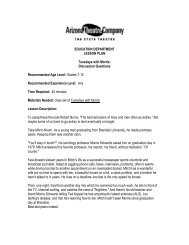Play Guide [356k PDF] - Arizona Theatre Company
Play Guide [356k PDF] - Arizona Theatre Company
Play Guide [356k PDF] - Arizona Theatre Company
- No tags were found...
You also want an ePaper? Increase the reach of your titles
YUMPU automatically turns print PDFs into web optimized ePapers that Google loves.
The Great GatsbySYMBOLISMSYMBOLISM IN THE GREAT GATSBYDr. T. J. Eckleburg: Fitzgerald describes the billboardadvertisement for the oculist thus: “But above the gray landand the spasms of bleak dust which drift endlessly overit, you perceive, after a moment, the eyes of Doctor T. J.Eckleburg. The eyes of Doctor T. J. Eckleburg are blue andgigantic—their irises are one yard high. They look out of noface, but, instead, from a pair of enormous yellow spectacleswhich pass over a nonexistent nose. Evidently some wildwag of an oculist set them there to fatten his practice inthe borough of Queens, and then sank down himself intoeternal blindness, or forgot them and moved away. But hiseyes, dimmed a little by many paintless days, under sun andrain, brood on over the solemn dumping ground.” Scholarsoften note that observation is an important theme whichA view of the valley of ashes,where George and MyrtleWilson live.runs through The Great Gatsby. Nick’s role as narrator and observer of all of the othercharacters presents him in a position of watching over everything that happens that fatefulsummer. Similarly, Gatsby is an observer at his parties, not truly taking part, but watchingover the festivities from a detached vantage point, rather than engaging in the drinkingand socializing in which his guests participate. Finally, theorists often liken the eyes of Dr.T. J. Eckleburg to the eyes of God in that the gigantic eyes are taking in all around them,perhaps silently judging the going-on that pass (including the car accident late in the book).However, the state of the eyes as described by Fitzgerald leads the reader to questionFitzgerald’s intention in that the billboard seems to be long forgotten and irrelevant, nolonger an actual useful advertisement. Perhaps Fitzgerald implies that whoever should bewatching is no longer interested.“It is sadder to find the past again and find it inadequate to the present than it is to have itelude you and remain forever a harmonious conception of memory.” – F. Scott FitzgeraldThe valley of ashes: The valley of ashes was a real place known as the Corona Ash Dumpduring Fitzgerald’s lifetime. It literally was a burning site for disposal of trash. Fitzgeralddescribes it in the novel: “This is a valley of ashes—a fantastic farm where ashes growlike wheat into ridges and hills and grotesque gardens, where ashes take the forms ofhouses and chimneys and rising smoke and finally, with a transcendent effort, of menwho move dimly and already crumbling through the powdery air. Occasionally a line ofgray cars crawls along an invisible track, gives out a ghastly creak and comes to rest, andimmediately the ash-gray men swarm up with leaden spades and stir up an impenetrablecloud which screens their obscure operations from your sight.” The desolation andisolation of the spot bleakly described by Fitzgerald corresponds with the lack of warmthand respect in the relationship of the inhabitants George and Myrtle. The valley of ashes is<strong>Arizona</strong> <strong>Theatre</strong> <strong>Company</strong> <strong>Play</strong> <strong>Guide</strong> 42


![Play Guide [356k PDF] - Arizona Theatre Company](https://img.yumpu.com/46218320/42/500x640/play-guide-356k-pdf-arizona-theatre-company.jpg)




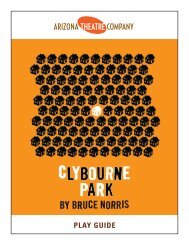
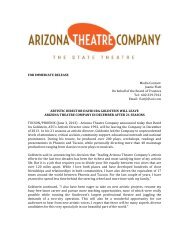


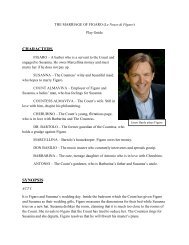
![[title of show] Arizona Theatre Company Play Guide 1](https://img.yumpu.com/24482689/1/190x245/title-of-show-arizona-theatre-company-play-guide-1.jpg?quality=85)
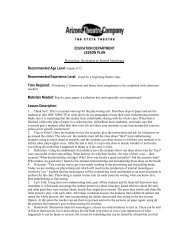
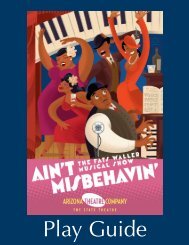
![Play Guide [1.2MB PDF] - Arizona Theatre Company](https://img.yumpu.com/11952176/1/190x245/play-guide-12mb-pdf-arizona-theatre-company.jpg?quality=85)
